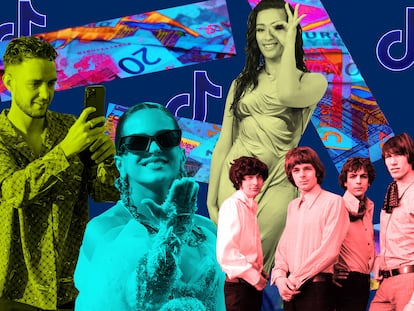TikTok is now Generation Z’s preferred search engine
Young people are using the addictive video platform to perform searches that were traditionally done on Google
Not very long ago, it appeared that Google was so consolidated that it was going to be invincible. But now, members of Generation Z – those born at the end of the 1990s and the beginning of the 2000s – are turning their backs on the search engine, using TikTok as a substitute.
This trend has not gone unnoticed by Google: Prabhakar Raghavan, a senior vice president at the company, has acknowledged that, according to his internal studies, 40% of Gen Zs use TikTok or Instagram – rather than Google – to search for information
“Before, whenever I had a doubt about something, I immediately went to Google, but now I go to TikTok first, because I trust it more and because of the content’s quality. Only when I’m not convinced, or when I don’t find what I’m looking for, do I use Google… and the truth is, that happens rarely,” admits Rosa Rodríguez, a 22-year-old TikTok user.
Like Rodríguez, millions of other young people turn to the Chinese platform rather than Google. They prefer TikTok, above all, because of speed… but also because, rather than having to read text, a TikTok video usually sums up info in a few seconds.
Dejen de buscar soluciones a todo por Google. Ahora tenemos tiktok.
— ✨fred at midnight✨ (@muchambre) August 14, 2022
Fátima Martínez, a social media consultant and author of The TikTok Book, explains that this platform has revolutionized everything:
“This is a totally different generation from the previous ones. TikTok gives you one minute videos, where they tell you at full-speed something you want to know. For example, with restaurant searches, you can go to Google and find what people think and see four photos, but [on] TikTok, you see videos of people who are in the restaurant, see what they eat, how they eat it, if the environment is pretty or not... these young people are much more used to everything visual, and they’re very lazy when it comes to seeking information.”
However, for Ubaldo Cuesta, a professor of communications at the Complutense University of Madrid, this trend is not exclusive to young people: “As the Polish philosopher Bauman said, we are moving towards liquid modernity and superficial thinking. Why is this
happening? In the first place, because thinking tires a person out – looking at a picture is easier, no? It’s much easier to move towards a liquid society – with constant mobility and change – than to move towards a society of reflection and thought.”
Cuesta says that young people have become “what Giovanni Sartori – the Italian political scientist – calls the Homo videns: man who lives by the image.”
“The brain is fundamentally visual and reacts very well to this type of stimuli… so, like television, TikTok very easily captures our attention,” the professor explains.
While the visual element doesn’t necessarily come at a high speed on long-form video platforms like YouTube, brevity is often the common feature of everything uploaded to TikTok. It’s very difficult to find a 10-minute-long video… the most common ones usually last for only a few seconds.
Martínez believes that “children try to run away from the real world because they don’t like it and they don’t see a future. They don’t think in terms of the future, but in the now… they have become accustomed to everything being very fast.”
According to data from software developer HubSpot, Gen Zs prefers to learn new things through video rather than through text or other traditional formats. In addition, they pay attention to content for an average of only eight seconds.
For Cuesta, this has a very important relationship with carpe diem and the search for diversion, something that the educator Neil Postman discussed in his bestselling book, Amusing ourselves to death (1985), a work that critiqued the general public’s addiction to amusement.
According to a study by Ofcom – the communications regulatory authority for the United Kingdom – the top three sources of information (and not just entertainment) for young people and teenagers are currently Instagram, TikTok and YouTube. However, José Luis Sanz, a 19-year-old TikTok user, argues that he continues using the Google search engine and reading about sports in print newspapers. He only uses videos for technical explanations or product reviews.
“I’m traditional,” he explains. Similarly, Sofía, a 16-year-old TikTok user, also continues to use Google to search for information.
Rodríguez explains that, unlike traditional search engines, she believes that TikTok offers “immediacy and proximity to the sender.”
“[The videos] offer content with much more understandable language, they generate more trust than a piece of text on Google – [the influencers] offer a reciprocal relationship,” she adds.
Professor Cuesta insists that the fact that there are “so many evaluators” (users who review and analyze services or products) on platforms like TikTok or YouTube “matches today’s society, which no longer trusts authority or institutions, but rather trusts a friend. [Gen Zs] prefer someone appearing on camera giving a succinct explanation, as if they are an acquaintance of theirs.”
Martínez notes that AI is powering TikTok’s content, totally changing the mentality of users. “TikTok shows you what you want to see. It’s totally addictive and it’s designed to be, in such a way that you are scrolling through videos vertically at full-speed. Google [is going to have] no choice but to adapt.
Ya se me hace más útil buscar cosas en TikTok que en Google
— RM (@reynasaldana) August 12, 2022
Tu suscripción se está usando en otro dispositivo
¿Quieres añadir otro usuario a tu suscripción?
Si continúas leyendo en este dispositivo, no se podrá leer en el otro.
FlechaTu suscripción se está usando en otro dispositivo y solo puedes acceder a EL PAÍS desde un dispositivo a la vez.
Si quieres compartir tu cuenta, cambia tu suscripción a la modalidad Premium, así podrás añadir otro usuario. Cada uno accederá con su propia cuenta de email, lo que os permitirá personalizar vuestra experiencia en EL PAÍS.
¿Tienes una suscripción de empresa? Accede aquí para contratar más cuentas.
En el caso de no saber quién está usando tu cuenta, te recomendamos cambiar tu contraseña aquí.
Si decides continuar compartiendo tu cuenta, este mensaje se mostrará en tu dispositivo y en el de la otra persona que está usando tu cuenta de forma indefinida, afectando a tu experiencia de lectura. Puedes consultar aquí los términos y condiciones de la suscripción digital.












































